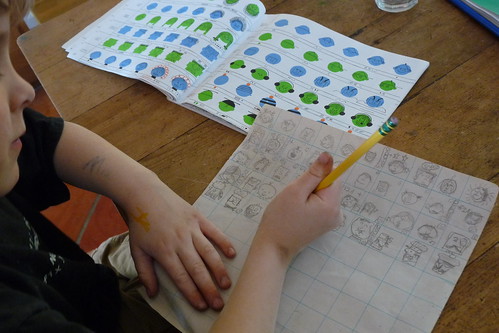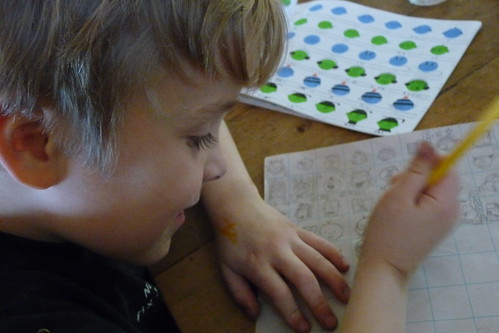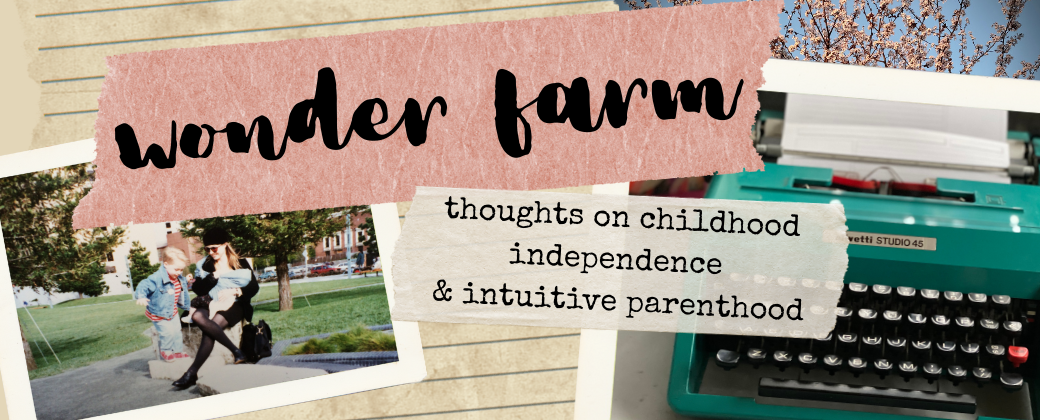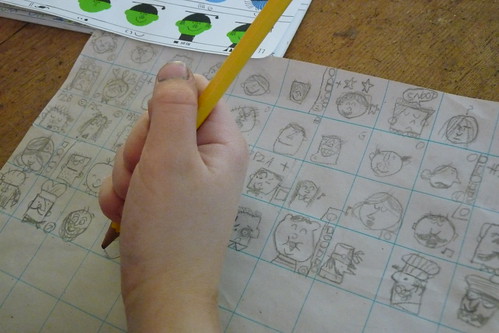Lately, Mr. T has been spending a lot of time with Ed Emberley.

I have my own fond memories from the 70’s of checking out armloads of Ed Emberley books from the bookmobile that parked near the tennis courts, in the suburban tract where I lived. I never thought of myself as able to draw, but with Ed’s simple step-by-steps, I could. My favorite was Make A World–all those tiny, tiny things, which I put together into great scenes.
Mr. T has no issues with his drawing abilities; still he’s having a fabulous time with Emberley’s Drawing Book of Faces. He’s been working on a series of faces within a graph paper grid.
He’s having as much fun drawing the faces as he’s having trying to read the character’s alliterative names. Conceited Conroy. Puzzled Polly. Black Eye Bob. His reading skills are just blooming these days, and it’s fun to hear him trying to figure out those names as he draws. His favorite is Monster Melvin.
Writing this post, I came across a link to Ed Emberley’s own site. Unfortunately, I can’t get it to run with the Flash Player I have, but the little flickers I could see of it look very cool. Somehow I was surprised to see that Ed is still alive. It seemed that someone who was writing books that were such a big part of my childhood would be gone by now.

Viva Ed Emberley!


Love that pencil grip!! (and the dirty fingernails).
Pencil grip story: I started obsessing a little over Maggie’s pencil grip, thinking it was part of what was slowing down her writing. So I started trying to work with her on this–something that did not please her, but she gave it a try.
About a week later, I was sitting at a meeting across from a highly competent graduate student who was taking notes using exactly the same pencil grip that I was trying to “cure” Maggie of.
I backed off. Instead (inspired by you!) we’ve been doing a lot of dictation. Maybe I’ll get a blog entry written about that….
Barbara–I’m so glad you’re taking Maggie’s dictation. I really believe that’s one of the best ways to help kids develop their voices as writers. They can focus on the words they have to tell, rather than putting letters on a page. (Which they can practice at other times.)
And oh, that pencil grip. Trying to convince Mr. T to hold the pencil differently only seems to make him more stubborn about doing it his way. And the older he gets, the more I wonder if he’ll ever change. Yet, he does very detailed art, and he forms letters well, so who am I to argue?
Did you ask the grad student about the pencil grip? I would love to know what an adult has to say about growing up writing that way.
We love Ed too 🙂
I loved seeing your son’s drawings. He must really enjoy making them! That’s a whole lotta faces! I can remember obsessively drawing girls and women when I was a kid, and the rapt pleasure I got out of that.
I have to chime in on the pencil grip, too. I’ve been worrying about the way my 6-yr-old son holds his pencil, especially since I read on one occupational therapy site (yes, I know, conflict of interest there, right?) that the wrong pencil grip can cause carpal tunnel-type issues later.
The funny thing is, I hold my pencil weird and would have very stubbornly resisted any attempts to change it as a kid. I have a funny little callous on my right ring finger due to my weird grip. It’s never held me up much other than that. I am so encouraged to see that other mamas are valuing expression over correct pencil grip. Hurray!
It is a lot of faces, Carrie. I hadn’t really counted them–he’s up to almost 50!
Who knew pencil grip issues were so common? The things you discover via blogging…
Viva indeed. Ed is a hero around our house, too!
Gorgeous pictures. I love his deep involvement.
I enjoyed reading about the connection you made when you viewed your son’s learning in relation to your own, when you were a child. The little details like: “the bookmobile that parked near the tennis courts, in the suburban tract where I lived” personalize this post nicely. It’s fun to be a part of their learning; to learn with them; and to reflect upon our own childhood experiences. That’s what this post suggests to me.
Ed is great. My kids have enjoyed learning how to make cartoon people look angry, sad, tired, puzzled. After reading about microexpressions and learning to read them in the news I began to wonder if the kids were learning to read real people better by learning how to draw the right eyebrows and liplines to make someone look frightened, excited, or dreamily happy.
Wow, Susan. I had never even considered that aspect of drawing comic faces, but I think it can have an impact on kids. Mr. T has definitely pointed out the nuances of facial expressions on characters he sees in books, or characters he’s drawn.
Maybe all this drawing will make him more sensitive to reading real people’s faces. Huh. Who’da thunk?
Hi Patricia—
Thanks for a great post about Ed Emberley and for showing your son’s drawings.
I am making a documentary film about Ed and the “Make a World” book and would be very interested in talking to you further. You can find some basic info on the project at http://swidinst.org/make-a-world-film/
Look forward to speaking with you soon!